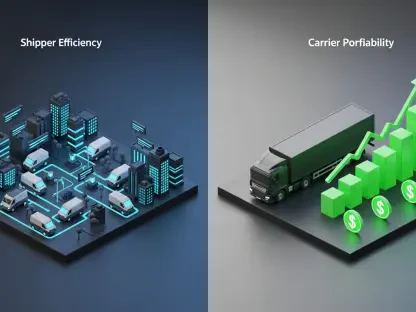In an era where digital infrastructure underpins nearly every facet of global commerce, business downtime emerges as a colossal threat, costing Global 2000 enterprises a staggering $400 billion annually. This equates to an average loss of $200 million per organization each year, as revealed by recent economic studies. The ripple effects of these disruptions—lost revenue, regulatory penalties, and tarnished reputations—pose a critical challenge to industries ranging from finance to manufacturing. This market analysis delves into the escalating costs of downtime, dissects current trends driving these disruptions, and projects future risks and opportunities for mitigation. By examining the data and strategies shaping this landscape, businesses can better navigate the high-stakes environment of operational continuity.
Market Dynamics: The Escalating Financial Burden of Downtime
The financial impact of downtime has reached unprecedented levels, with current estimates pegging the per-minute cost at $9,000, or $540,000 per hour, for large enterprises. This burden is most acutely felt in sectors like e-commerce and financial services, where even brief interruptions can lead to significant transaction losses. Beyond direct revenue impacts, indirect costs such as customer attrition and brand damage further compound the economic toll, often requiring multimillion-dollar campaigns to restore trust. As digital dependency grows across industries, the market for downtime prevention solutions is expanding rapidly, driven by the urgent need to safeguard critical systems.
This trend is particularly evident as companies increasingly rely on sprawling IT ecosystems that span on-premises and cloud environments. The complexity of these systems amplifies the risk of unplanned outages, whether triggered by internal errors or external threats. Market data indicates that the cost of downtime is not just a static figure but a dynamic challenge, escalating with the scale of digital transformation. Over the next few years, from 2025 to 2027, projections suggest that these costs could rise further as businesses integrate more interconnected technologies, underscoring the pressing demand for robust resilience strategies.
Key Drivers of Downtime: A Sectoral and Systemic Analysis
Human Error: The Persistent Market Vulnerability
Across industries, human error remains a dominant factor in downtime incidents, particularly in data centers and IT operations. Recent analyses highlight that staff failing to adhere to protocols or mishandling complex systems accounts for a significant share of outages. This issue is especially prevalent in sectors like healthcare and telecommunications, where rapid software updates and intricate hardware configurations often outpace employee training. The market for training programs and automated error-detection tools is thus witnessing growth as companies seek to address this root cause.
The challenge lies not only in individual mistakes but also in systemic gaps, such as inadequate processes or documentation. As IT environments become more sophisticated, the likelihood of errors increases, pushing businesses to invest in standardized procedures and real-time monitoring solutions. This trend is shaping a niche market for consulting services that specialize in operational audits and staff upskilling, aimed at reducing human-induced disruptions in high-stakes industries.
Technical Complexities: Navigating an Evolving IT Landscape
Technical challenges form another critical driver of downtime, fueled by the rapid evolution of IT infrastructure across global markets. Frequent changes in applications, integrations, and cloud-based systems—such as autoscaling or updated firewall rules—create a dynamic environment prone to misconfigurations. In sectors like retail and logistics, where real-time data processing is vital, these technical intricacies often lead to costly interruptions, prompting a surge in demand for dependency mapping and infrastructure management tools.
Aging infrastructure adds a further layer of risk, with a substantial portion of mission-critical IT systems nearing end-of-life status in many organizations. This issue is particularly acute in manufacturing and energy sectors, where legacy systems struggle to support modern workloads. Market trends point to a growing investment in modernization initiatives, as companies prioritize upgrades to mitigate the financial fallout from technical failures. The balance between innovation and maintenance is becoming a key focus for IT budgets worldwide.
External Disruptions: The Unpredictable Market Threats
External factors, including cyberattacks and natural disasters, represent a significant and often uncontrollable segment of downtime risks. Cybersecurity breaches, such as ransomware attacks, are on the rise, targeting vulnerabilities in widely used platforms and disrupting operations in industries like finance and government services. The market for cybersecurity solutions is booming in response, with businesses allocating larger budgets toward threat detection and incident response capabilities to counter these external menaces.
Beyond cyber threats, power grid failures, extreme weather events, and third-party provider outages continue to impact operational continuity. Data shows that external service providers account for a majority of publicly reported outages, affecting sectors reliant on cloud and telecom services. This has spurred a market shift toward comprehensive disaster recovery frameworks and stricter vendor accountability, as companies seek to insulate themselves from disruptions beyond their direct control.
Future Projections: Emerging Tools and Market Risks
Looking ahead, the market for downtime prevention is poised for transformation, driven by advancements in technology and evolving threats. Artificial Intelligence (AI) platforms are gaining traction for their ability to predict and prevent outages through pattern analysis across IT ecosystems, offering substantial cost savings for enterprises in tech-heavy sectors like software development and online retail. The adoption of AI-driven operations is projected to accelerate from 2025 onward, reshaping how businesses approach system reliability.
However, this technological progress comes with new risks, as increasing reliance on cloud services introduces vulnerabilities tied to external provider failures. Regulatory pressures around data protection and system availability are also expected to intensify, influencing market behavior by pushing companies to allocate more resources toward compliance and resilience. The future landscape suggests a dual focus: leveraging cutting-edge tools while bracing for sophisticated cyber threats and stricter oversight, a balance that will define competitive advantage in the coming years.
Strategic Implications: Building a Resilient Market Position
Reflecting on the insights gained, it is clear that downtime imposes a profound financial strain on global enterprises, with costs and risks escalating alongside digital dependency. The analysis of market drivers—human error, technical challenges, and external threats—reveals critical vulnerabilities that demand urgent attention across industries. Sectors most affected, such as finance and e-commerce, face the highest stakes, where even minor disruptions translate into significant losses.
Moving forward, businesses should prioritize actionable steps like conducting thorough Business Impact Analyses to pinpoint critical systems for targeted investments. Developing integrated Business Continuity and Disaster Recovery plans, coupled with cyber-resilience strategies, emerges as essential for mitigating both planned and unforeseen disruptions. Additionally, embracing AI for predictive maintenance and rigorously vetting cloud providers for fault tolerance offers promising avenues to strengthen operational defenses. By adopting these measures, companies can transform the challenge of downtime into an opportunity to build enduring trust and reliability in a competitive global market.









